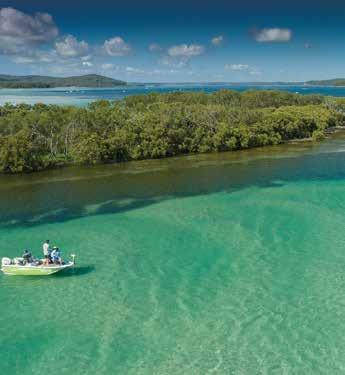
4 minute read
4.1 Preparation of the CMP
Council’s approach to preparing the CMP is outlined below.
STAGE 1
Identify the scope of CMP
STAGE 2
Determine risks, vulnerabilities and opportunities
STAGE 3
Identify and evaluate options
STAGE 4
STAGE 5
Implement, monitor, evaluate and report
Stage One
The scoping study prepared as part of Stage One of the CMP was completed in December 2020 and is provided in Appendix 2.
Stage Two
During Stage Two, a wave overtopping assessment for the coastline and a surf amenity assessment for Blacksmiths Beach were carried out. A State of the Estuary Report was also completed, and a water level analysis. Refer to section 4.3. Recommendations and identified options from these studies have been considered and incorporated into the Implementation Plan.
Stage Three
Stage Three of the CMP involved the identification and evaluation of options. A detailed options evaluation process was undertaken with the assistance of Umwelt and is provided in Appendix 8. This process was undertaken to fulfil the mandatory requirements of the Coastal Manual, being: • MR6(iii) During preparation of a CMP, a council is to evaluate and select coastal management actions (to address the most important risks) • MR8(v) A CMP must identify how the coastal management actions have been considered and evaluated, including without limitation, how the council has evaluated the coastal management actions in light of the functions and responsibilities of council under legislation other than the CM Act.
Options were identified by reviewing the implementation status of CZMP actions, addressing issues and gaps identified in Stages One and Two and through consultation with the community and relevant stakeholders.
An evaluation of these options was then carried out. The aim of the evaluation was to determine if strategic actions offer good value for money. Where an action was modified from a previous management response, the evaluation should show how the new option offered better value for money than the previous approach. The existing management of the coastal zone of Lake Macquarie, including management responses for risks in the main body of the estuary, the channel and for the open coastline, is the ‘base case’ for this assessment.
Short benefit statements have been prepared for all actions to describe the technical benefits provided by the action. In addition to these technical evidence benefits, Council’s community satisfaction survey results provide evidence that investment in projects that protect, restore and enhance the natural environment is highly regarded by the community. Coastal zone management (lake, foreshore, coastline) is identified as a very important service, with high levels of satisfaction. This management protects one of the most valued reasons for living in Lake Macquarie. By identifying environmental concerns as a priority over the next decade, the community has recognised there there are significant challenges for the coastal zone and ongoing investment in the health of coastal systems and the benefits they provide for the community, is important and supported. The outcome of this evaluation has resulted in 111 priority actions identified in the CMP. These actions make up the Implementation Plan included as section 4.4.
Stage Three also involved the preparation of a business plan, which was prepared by Umwelt to meet the following mandatory requirements.
• MR8(x) A CMP must include a business plan • MR9(i) The business plan must identify all proposed management actions identified elsewhere in the
CMP • MR9(ii) The business plan included in the CMP must identify the full proposed capital, operational and maintenance costs and recommended timing of proposed coastal management actions. The business plan is detailed in section 4.5 and Appendix 4.
Stage Four
Stage Four is to prepare, exhibit, finalise, certify and adopt the CMP and associated documentation.
Community and stakeholder engagement
A Community Engagement Plan was prepared for Stages 1-5 of the Lake Macquarie CMP. Refer to Appendix 3 for details on engagement activities. The stakeholder groups involved in preparation of the CMP included Council’s Coastal Zone Management Committee and an external stakeholder group, with membership from: • Hunter Water Corporation • DPI Fisheries • Marine Infrastructure Delivery Office • Environment Protection Authority • City of Newcastle • NSW National Parks and Wildlife Service • Sustainable Neighbourhood Groups • Hunter Surf Life Saving • Central Coast Council • Local Aboriginal Land Councils • Aboriginal traditional owners groups • Roads and Maritime Service • Belmont Wetlands State Park • Transport for NSW • Local environmental advocacy groups • Department of Planning, Industry and Environment - Biodiversity and Conservation Division - Science, Economics and Environment division - Crown Lands
Council’s online Shape Lake Mac platform was used to deliver updates, documents and studies to the community, with online workshops and presentations provided at key milestones and contribution points during Stages 1-4. Aboriginal community groups (Land Councils and traditional owner groups) were contacted individually, seeking their comments and contributions to the CMP. During Stage Two, an online meeting was held with the external stakeholder group to share findings from the studies carried out during this stage, with recommendations from the studies informing the actions developed in Stage Three. At each meeting of the Coastal Zone Management Committee, an update on the CMP was provided. During Stage Three (October 2021), a series of external stakeholder workshops was held online to review the draft CMP actions for each area of the coastal zone. These workshops resulted in the generation of 30-40 new actions for inclusion, and amendments and additions to many existing actions. Identifying partners to implement each action was a significant part of this engagement. Engagement with Council staff and elected representatives has occurred during preparation of the CMP. An internal interdepartmental working group was formed in Stage One of the CMP and this group has been involved with the risk assessment analysis and actions development and review. Detailed discussions have occurred with other agencies identified as a lead or action partner to establish commitment and determine funding mechanisms.









